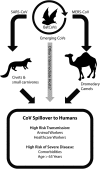Broad-spectrum coronavirus antiviral drug discovery
- PMID: 30849247
- PMCID: PMC7103675
- DOI: 10.1080/17460441.2019.1581171
Broad-spectrum coronavirus antiviral drug discovery
Abstract
The highly pathogenic coronaviruses severe acute respiratory syndrome coronavirus (SARS-CoV) and Middle East respiratory syndrome coronavirus (MERS-CoV) are lethal zoonotic viruses that have emerged into human populations these past 15 years. These coronaviruses are associated with novel respiratory syndromes that spread from person-to-person via close contact, resulting in high morbidity and mortality caused by the progression to Acute Respiratory Distress Syndrome (ARDS). Areas covered: The risks of re-emergence of SARS-CoV from bat reservoir hosts, the persistence of MERS-CoV circulation, and the potential for future emergence of novel coronaviruses indicate antiviral drug discovery will require activity against multiple coronaviruses. In this review, approaches that antagonize viral nonstructural proteins, neutralize structural proteins, or modulate essential host elements of viral infection with varying levels of efficacy in models of highly pathogenic coronavirus disease are discussed. Expert opinion: Treatment of SARS and MERS in outbreak settings has focused on therapeutics with general antiviral activity and good safety profiles rather than efficacy data provided by cellular, rodent, or nonhuman primate models of highly pathogenic coronavirus infection. Based on lessons learned from SARS and MERS outbreaks, lack of drugs capable of pan-coronavirus antiviral activity increases the vulnerability of public health systems to a highly pathogenic coronavirus pandemic.
Keywords: ARDS; Antiviral; MERS; MERS-CoV; Middle East respiratory syndrome; SARS; SARS-CoV; acute respiratory distress syndrome; bat; broad-spectrum; camel; civet; coronavirus; emerging virus; highly pathogenic virus; human cases; in vitro model; interferon; lopinavir; pneumonia; primate model; respiratory; ribavirin; rodent model; severe acute respiratory syndrome; therapeutic; zoonosis; zoonotic.
Figures



Comment in
-
Coronavirus 2019-nCoV: Is the genie already out of the bottle?Travel Med Infect Dis. 2020 May-Jun;35:101577. doi: 10.1016/j.tmaid.2020.101577. Epub 2020 Feb 7. Travel Med Infect Dis. 2020. PMID: 32044388 Free PMC article. No abstract available.
Similar articles
-
Abelson Kinase Inhibitors Are Potent Inhibitors of Severe Acute Respiratory Syndrome Coronavirus and Middle East Respiratory Syndrome Coronavirus Fusion.J Virol. 2016 Sep 12;90(19):8924-33. doi: 10.1128/JVI.01429-16. Print 2016 Oct 1. J Virol. 2016. PMID: 27466418 Free PMC article.
-
Remdesivir against COVID-19 and Other Viral Diseases.Clin Microbiol Rev. 2020 Oct 14;34(1):e00162-20. doi: 10.1128/CMR.00162-20. Print 2020 Dec 16. Clin Microbiol Rev. 2020. PMID: 33055231 Free PMC article. Review.
-
SARS, MERS and SARS-CoV-2 (COVID-19) treatment: a patent review.Expert Opin Ther Pat. 2020 Aug;30(8):567-579. doi: 10.1080/13543776.2020.1772231. Epub 2020 Jun 7. Expert Opin Ther Pat. 2020. PMID: 32429703 Review.
-
The broad-spectrum antiviral recommendations for drug discovery against COVID-19.Drug Metab Rev. 2020 Aug;52(3):408-424. doi: 10.1080/03602532.2020.1770782. Epub 2020 Jun 17. Drug Metab Rev. 2020. PMID: 32546018 Free PMC article. Review.
-
In vitro virucidal activity of Echinaforce®, an Echinacea purpurea preparation, against coronaviruses, including common cold coronavirus 229E and SARS-CoV-2.Virol J. 2020 Sep 9;17(1):136. doi: 10.1186/s12985-020-01401-2. Virol J. 2020. PMID: 32907596 Free PMC article.
Cited by
-
Clinical features of hypertensive patients with COVID-19 compared with a normotensive group: Single-center experience in China.Open Med (Wars). 2021 Mar 3;16(1):367-374. doi: 10.1515/med-2021-0225. eCollection 2021. Open Med (Wars). 2021. PMID: 33869774 Free PMC article.
-
The battle between host and SARS-CoV-2: Innate immunity and viral evasion strategies.Mol Ther. 2022 May 4;30(5):1869-1884. doi: 10.1016/j.ymthe.2022.02.014. Epub 2022 Feb 14. Mol Ther. 2022. PMID: 35176485 Free PMC article. Review.
-
Interferons in the Therapy of Severe Coronavirus Infections: A Critical Analysis and Recollection of a Forgotten Therapeutic Regimen with Interferon Beta.Drug Res (Stuttg). 2020 Jul;70(7):291-297. doi: 10.1055/a-1170-4395. Epub 2020 May 22. Drug Res (Stuttg). 2020. PMID: 32443163 Free PMC article.
-
Computational drug discovery and repurposing for the treatment of COVID-19: A systematic review.Bioorg Chem. 2021 Jan;106:104490. doi: 10.1016/j.bioorg.2020.104490. Epub 2020 Nov 19. Bioorg Chem. 2021. PMID: 33261845 Free PMC article.
-
The genetic structure of SARS-CoV-2 does not rule out a laboratory origin: SARS-COV-2 chimeric structure and furin cleavage site might be the result of genetic manipulation.Bioessays. 2021 Mar;43(3):e2000240. doi: 10.1002/bies.202000240. Epub 2020 Nov 17. Bioessays. 2021. PMID: 33200842 Free PMC article.
References
-
- Ksiazek TG, Erdman D, Goldsmith CS, et al. A novel coronavirus associated with severe acute respiratory syndrome. N Engl J Med. 2003;348(20):1953–1966. - PubMed
-
- Drosten C, Günther S, Preiser W, et al. Identification of a novel coronavirus in patients with severe acute respiratory syndrome. N Engl J Med. 2003;348(20):1967–1976. - PubMed
-
- Zaki AM, van Boheemen S, Bestebroer TM, et al. Isolation of a novel coronavirus from a man with pneumonia in Saudi Arabia. N Engl J Med. 2012;367(19):1814–1820. - PubMed
-
- Lew TWK, Kwek T-K, Tai D, et al. Acute respiratory distress syndrome in critically Ill patients with severe acute respiratory syndrome. JAMA. 2003;290(3):374–380. Available from: http://jama.ama-assn.org/cgi/content/abstract/290/3/374 - PubMed
-
- WHO Summary of probable SARS cases with onset of illness from 1 November 2002 to 31 July 2003. [cited 2019 January25] Available from: http://www.who.int/csr/sars/country/table2004_04_21/en/index.html
Publication types
MeSH terms
Substances
LinkOut - more resources
Full Text Sources
Other Literature Sources
Medical
Miscellaneous
